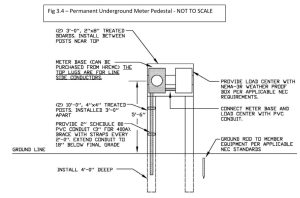New and Temporary Services
The first step in arranging for a new electrical service is to call Warren County REMC and speak with the service orders department. In most cases, you will be asked to stake off the approximate location of the future structure. A staking engineer will then make a site trip to your property and put together an estimate for your review. In some cases, an appointment to meet on-site with a staking engineer will be required to discuss the routing and location of equipment. It is recommended to call as far in advance as possible (at least one month) to ensure sufficient time to design, plan and install a new service.
At the time of application, the member should be prepared to provide the following information.
If the service is for a permanently occupied home or partially occupied structure (a camp, barn, or garage, for example):
- Name(s) on the account
- Service address
- Permit number
- All current telephone numbers and email address(es)
- Anticipated service size and voltage (200A, 400A, 120/240V)
- Approximate square footage
- HVAC system (gas or electric)
- Recorded warranty deed for the property
The cost of a new service will be based on the amount of work and materials required to extend REMC equipment to the member meter base. When the staking engineer has completed his/her design and associated costs, you will be contacted to review this information. The cost of the new service will be required to be paid prior to Warren County REMC performing any work. Exceptions to paying in full are available, however, they must be approved prior to any work being performed. Please call an REMC representative to discuss options at 844-224-0710 or 765-762-6114.
In most cases, a member can have a temporary service installed on the construction site to aid in construction until provisions are made for the permanent structure. Please refer to the “Temporary Service” section for member requirements. After substantial completion of the structure and a passed electrical inspection, the permanent service can be installed. Please refer to the “Permanent Service” section for member requirements.
If you are simply reconnecting a previously existing service, this should be stated and a “work order” can be developed to perform this work. Please refer to “Warren County REMC Member Cost/Fees.” If service has been disconnected for one year or more, an inspection and credit check are required, and fees may apply.
Please contact us by calling Warren County REMC’s main number at 844-224-0710 or 765-762-6114. Please have the above information prior to calling.
A temporary electric service is defined as supplying a site with electrical power for ONE YEAR OR LESS. The most common use of a temporary service is to supply power to a construction site until provisions are made on a permanent structure for an electrical service. If permanent provisions are not provided within one year, Warren County REMC will return to disconnect service. Temporary services are to be located outside of the reserved work area.
To begin the process of seeking a temporary service, please refer to “Applying for Electric Service.”
Available Services
This section will cover 120/240V requirements for temporary service. If a higher voltage temporary service is required, please contact the systems engineer to discuss your requirements.
2.1 Temporary Overhead Services
It is the member’s/contractor’s responsibility to install equipment per applicable NEC standards. Refer to Fig 2.1 for Temporary Overhead Service requirement.
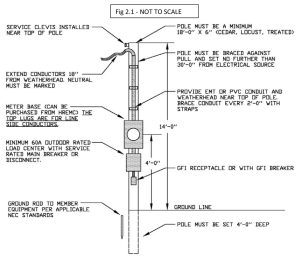
2.2 Temporary Underground Services
It is the member’s/contractor’s responsibility to install their equipment per applicable NEC standards. Refer to Fig 2.2 for Temporary Overhead Service requirements.
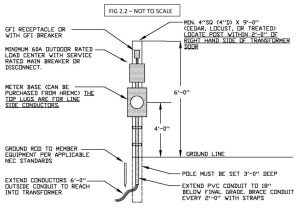
The permanent service will be installed upon the structure passing an electrical inspection. Please contact your local Planning and Zoning Office to determine the electrical inspection requirements. It is the member’s/contractor’s responsibility to install equipment per applicable NEC standards. Warren County REMC is not responsible for damage to member property or persons due to faulty installation of member equipment.
To begin the process of seeking a permanent service, please refer to “Applying for Electric Service.”
Available Services
This section will cover 120/240V requirements for permanent service. If a higher voltage permanent service is required, please contact the systems engineer to discuss your requirements.
3.1 Permanent Overhead Service
Refer to Fig 3.1 for Permanent Single Story Overhead Service Requirements. Refer to Fig 3.2 for Multi Story Overhead Service. It is the member’s/contractor’s responsibility to install their equipment per applicable NEC standards. All permanent meter bases are to be provided with bypass capability. This is in an effort to reduce member power outages in the event a member meter base requires maintenance or replacement.
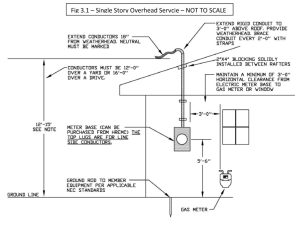
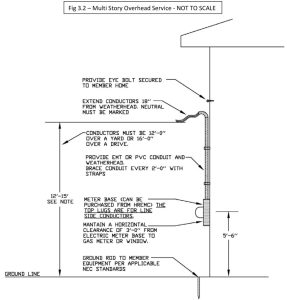
Overhead Meter Pole
Overhead meter poles are no longer allowed to be constructed. If a meter base cannot be installed on the structure, a permanent underground meter pedestal can be utilized. Please see Permanent Underground Meter Pedestal in this section for further requirements.
3.2 Permanent Underground Service
Refer to Fig 3.2 for Permanent Underground Service requirements. It is the member’s/contractor’s responsibility to install their equipment per applicable NEC standards. All permanent meter bases are to be provided with bypass capability. This is in an effort to reduce member power outages in the event a member meter base requires maintenance or replacement.
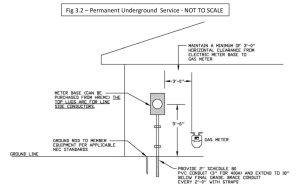
Permanent URD Meter Pedestal
If mounting a meter base on a structure (i.e., house or garage) is not feasible or desired (i.e., camp or mobile home), a permanent underground meter base can be installed. These can be purchased as a pre‐constructed device from REMC or your local electrical supply house. Please see the “Warren County REMC Member Cost/Fees” section for pricing. As an alternative, the member can construct a permanent meter pedestal. See Fig 3.4 for strict requirements of this construction. The meter pedestal requires a minimum of 3’‐0’’ of working clearance all around the meter pedestal. All permanent meter bases are to be provided with bypass capability. This is in an effort to reduce member power outages in the event a member meter base requires maintenance or replacement.
